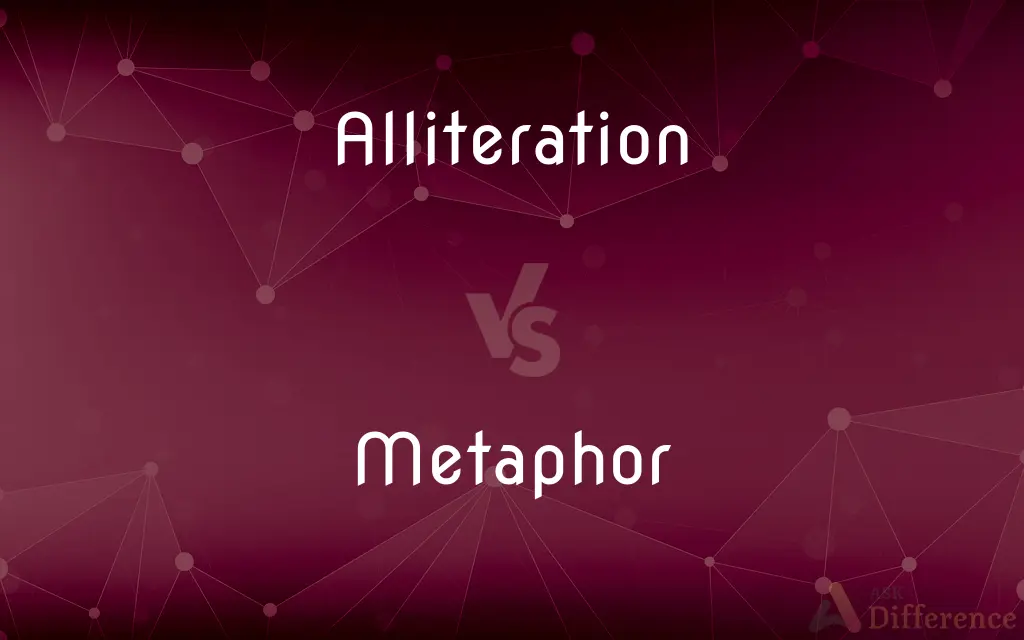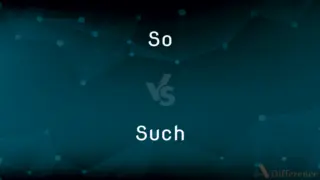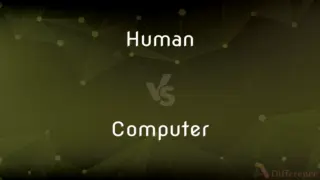Alliteration vs. Metaphor — What's the Difference?
Edited by Tayyaba Rehman — By Fiza Rafique — Updated on April 21, 2024
Alliteration involves the repetition of initial consonant sounds in words close together, while a metaphor is a figure of speech comparing two unrelated things without using "like" or "as."

Difference Between Alliteration and Metaphor
Table of Contents
ADVERTISEMENT
Key Differences
Alliteration focuses on the sound quality of words, enhancing rhythm and musicality in phrases by repeating the same consonant sound at the start of closely situated words. On the other hand, a metaphor enriches the meaning of a text by directly equating one thing with another, often unrelated, to highlight their similarities.
An example of alliteration might be "She sells sea shells by the sea shore," where the 's' sound is repeated. In contrast, a metaphor like "Time is a thief" suggests time steals moments from us without literally being a thief.
Poets and writers use alliteration to create a pleasing auditory effect and to emphasize certain parts of their text, which aids in memory and impact. Conversely, metaphors are used to convey complex ideas and emotions by connecting the reader’s understanding of one thing to another through symbolic meaning.
Alliteration is typically confined to the structure and phonetics of words, requiring only a repetition of sounds. Whereas metaphors require a deeper layer of interpretation, inviting readers to find and understand the implicit connections between the compared elements.
While alliteration enhances the aesthetic and rhythmic qualities of language, making it popular in poetry, tongue twisters, and branding, metaphors serve to deepen understanding, often providing new insights or expressing ideas in novel ways, which is crucial in literature and everyday language.
ADVERTISEMENT
Comparison Chart
Definition
Repetition of the same consonant sounds
Comparison between two unlike things directly
Purpose
Enhances phonetic rhythm and aesthetics
Illustrates and deepens conceptual understanding
Usage Examples
"Peter Piper picked a peck of pickled peppers"
"America is a melting pot"
Required Elements
Same starting sounds
Imaginative connection between different concepts
Literary Effect
Auditory and mnemonic enhancement
Symbolic and conceptual enrichment
Compare with Definitions
Alliteration
Used for poetic or rhetorical effect.
The big, bad bear frightened all the forest folk.
Metaphor
Rich in emotional content.
A wave of sadness washed over him.
Alliteration
Often found in brand names and slogans.
Dunkin’ Donuts delivers delicious desserts daily.
Metaphor
A direct comparison between two unrelated subjects.
Her eyes were windows to her soul.
Alliteration
Emphasizes particular sounds in speech.
Whisper words of wisdom, let it be.
Metaphor
Used to convey deeper symbolic meanings.
The world’s a stage, and we are merely players.
Alliteration
Makes language memorable.
Better butter makes the batter better.
Metaphor
Expresses complexity simply.
His words cut deeper than a knife.
Alliteration
Repetition of consonants at the start of words close to each other.
The cool, crisp air caressed her calmly.
Metaphor
Encourages creative and critical thinking.
Life is a journey, travel it well.
Alliteration
The repetition of consonant sounds at the beginning of two or more words immediately succeeding each other, or at short intervals.
Metaphor
A metaphor is a figure of speech that, for rhetorical effect, directly refers to one thing by mentioning another. It may provide (or obscure) clarity or identify hidden similarities between two different ideas.
Alliteration
In literature, alliteration is the conspicuous repetition of identical initial consonant sounds in successive or closely associated syllables within a group of words, even those spelled differently. As a method of linking words for effect, alliteration is also called head rhyme or initial rhyme.
Metaphor
A figure of speech in which a word or phrase is applied to an object or action to which it is not literally applicable
Her poetry depends on suggestion and metaphor
When we speak of gene maps and gene mapping, we use a cartographic metaphor
Alliteration
The occurrence of the same letter or sound at the beginning of adjacent or closely connected words
The alliteration of ‘sweet birds sang’
Alliterations are clustered in the last few lines
Metaphor
A figure of speech in which a word or phrase that ordinarily designates one thing is used to designate another, thus making an implicit comparison, as in "a sea of troubles" or "All the world's a stage" (Shakespeare).
Alliteration
The repetition of identical or similar sounds at the beginning of words or in stressed syllables, as in "on scrolls of silver snowy sentences" (Hart Crane). Modern alliteration is predominantly consonantal; certain literary traditions, such as Old English verse, also alliterate using vowel sounds.
Metaphor
One thing conceived as representing another; a symbol
"Hollywood has always been an irresistible, prefabricated metaphor for the crass, the materialistic, the shallow, and the craven" (Neal Gabler).
Alliteration
The recurrence of the same letter in accented parts of words, as in Anglo-Saxon alliterative meter.
Metaphor
The use of a word or phrase to refer to something other than its literal meaning, invoking an implicit similarity between the thing described and what is denoted by the word or phrase.
Alliteration
The repetition of the same letter at the beginning of two or more words immediately succeeding each other, or at short intervals; as in the following lines: -
Behemoth, biggest born of earth, upheavedHis vastness.
Fly o'er waste fens and windy fields.
In a somer seson whan soft was the sonne,I shope me in shroudes as I a shepe were.
Metaphor
A word or phrase used in such implied comparison.
Alliteration
Use of the same consonant at the beginning of each stressed syllable in a line of verse;
Around the rock the ragged rascal ran
Metaphor
The use of an everyday object or concept to represent an underlying facet of the computer and thus aid users in performing tasks.
Desktop metaphor; wastebasket metaphor
Metaphor
(intransitive) To use a metaphor.
Metaphor
(transitive) To describe by means of a metaphor.
Metaphor
The transference of the relation between one set of objects to another set for the purpose of brief explanation; a compressed simile; e. g., the ship plows the sea.
Metaphor
A figure of speech in which an expression is used to refer to something that it does not literally denote in order to suggest a similarity
Common Curiosities
What is an example of a metaphor in everyday speech?
Phrases like "He has a heart of stone" are metaphoric in everyday use.
Can alliteration appear in prose as well as poetry?
Yes, alliteration can be used in both prose and poetry for emphasis and effect.
How does a metaphor differ from a simile?
Metaphors imply a direct comparison without using "like" or "as," whereas similes use them.
What are some common effects of using metaphors?
Metaphors can enhance understanding, evoke emotions, and create vivid imagery.
What makes alliteration effective in advertising?
Its mnemonic quality makes it useful in making brand names and slogans stickier and more memorable.
What is the main purpose of alliteration?
Alliteration enhances the musicality and memorability of language.
How does alliteration impact the readability of a text?
Alliteration can make text more engaging and enjoyable to read.
Is metaphor used only in creative writing?
No, metaphor is also used in everyday language to express complex ideas simply.
Does alliteration always involve consonants?
Primarily, though it can occasionally involve vowel sounds in certain contexts.
How do metaphors influence a reader’s perception?
They encourage deeper interpretation and can shift a reader’s perception of a topic.
Share Your Discovery

Previous Comparison
So vs. Such
Next Comparison
Human vs. ComputerAuthor Spotlight
Written by
Fiza RafiqueFiza Rafique is a skilled content writer at AskDifference.com, where she meticulously refines and enhances written pieces. Drawing from her vast editorial expertise, Fiza ensures clarity, accuracy, and precision in every article. Passionate about language, she continually seeks to elevate the quality of content for readers worldwide.
Edited by
Tayyaba RehmanTayyaba Rehman is a distinguished writer, currently serving as a primary contributor to askdifference.com. As a researcher in semantics and etymology, Tayyaba's passion for the complexity of languages and their distinctions has found a perfect home on the platform. Tayyaba delves into the intricacies of language, distinguishing between commonly confused words and phrases, thereby providing clarity for readers worldwide.
















































